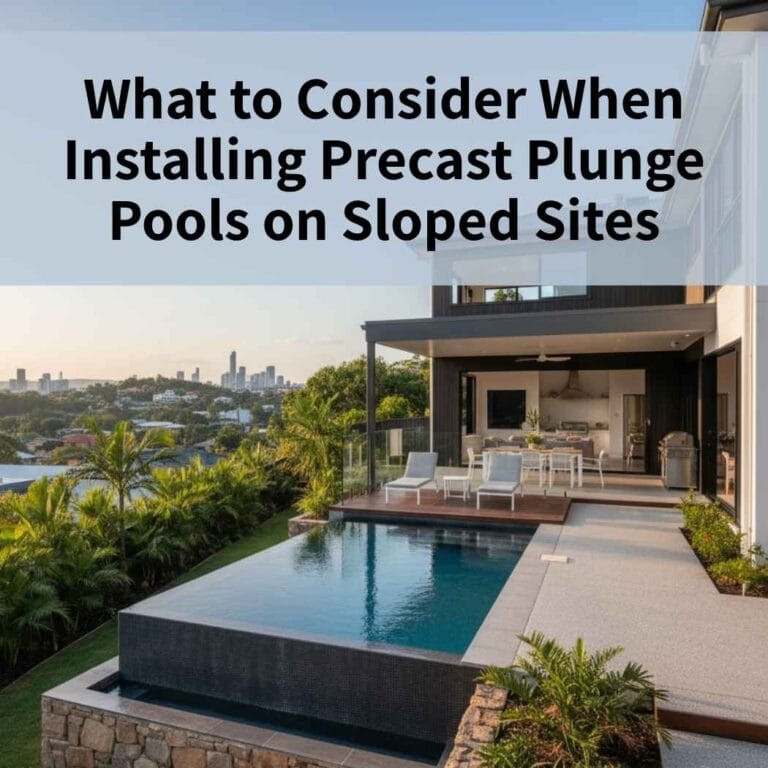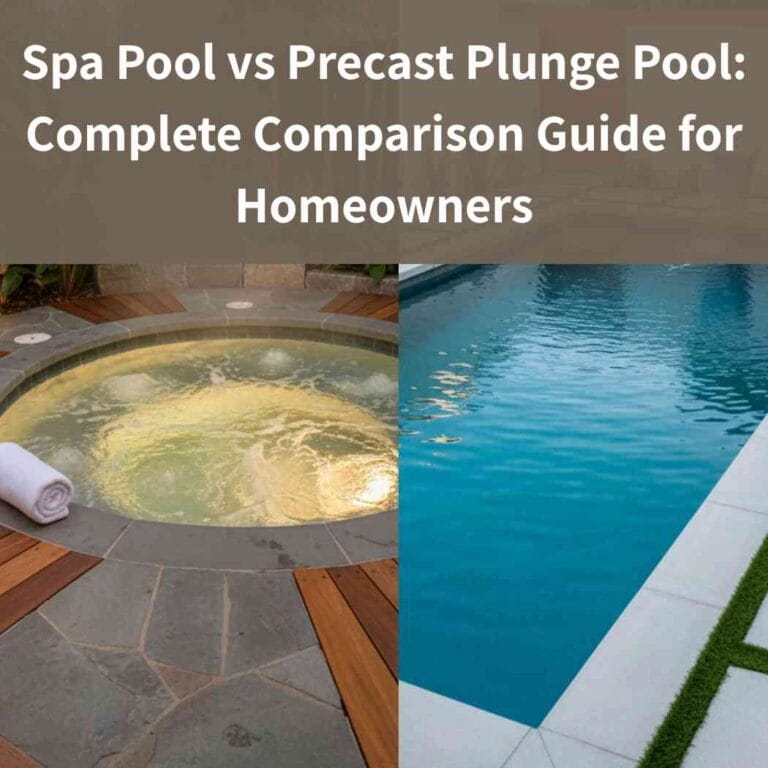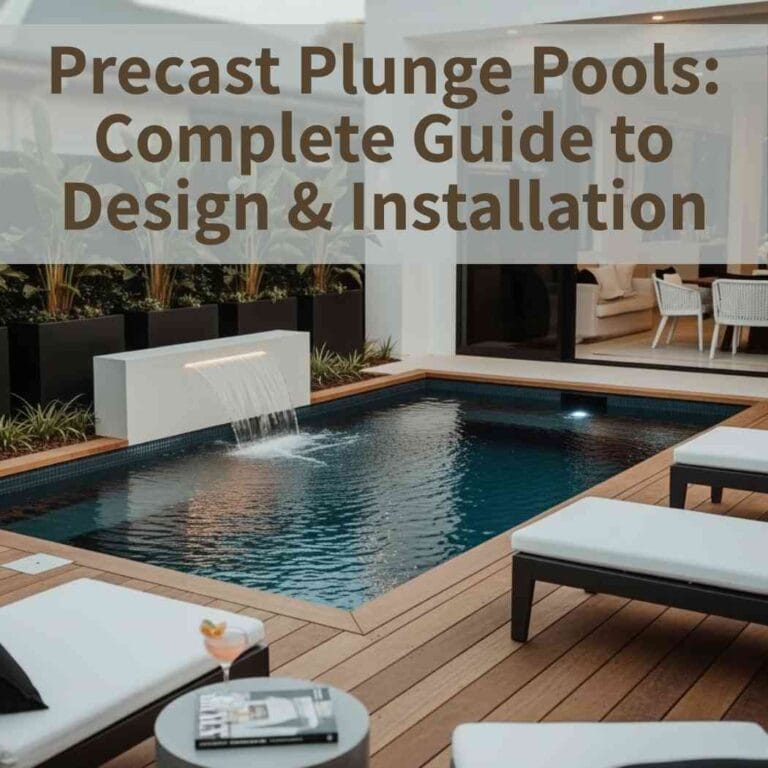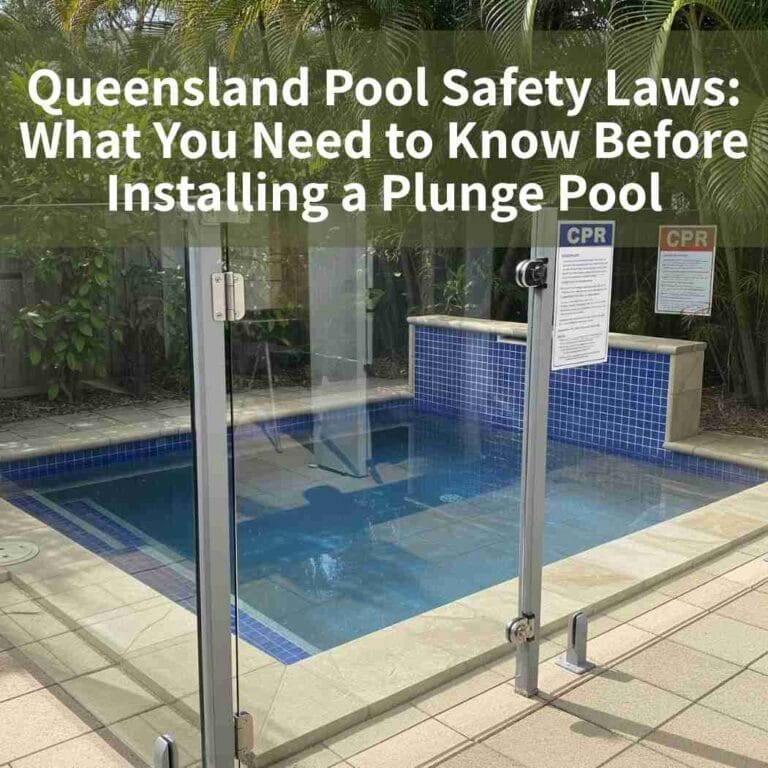At Plunge Pools Brisbane, we specialise in building precast plunge pools on sloping blocks across the city. Our team designs pools that suit the land and follow local compliance rules.
This guide explains everything you need before installing a precast plunge pool on a slope, including site checks, retaining walls, drainage systems, decking, infinity edges, costs, landscaping, and seasonal tips.
Table of Contents
ToggleSite Assessment Before Installation
A site assessment checks soil type, slope angle, and site access before installing a plunge pool. In Brisbane, it’s vital because soft soils, steep slopes, or narrow streets can change the cost and design. Engineers use reports to confirm stability and safety before work begins.
Why Site Checks Matter
Before building a precast plunge pool on a slope, you need a proper site assessment. It shows if the ground can hold the pool safely, how much excavation is needed, and whether cranes can reach the site. This step prevents costly mistakes later.
Soil Types in Brisbane
Soils in Brisbane suburbs vary, and they affect how a pool can be installed:
- M-class soil (moderate): Some movement with moisture. Usually needs light reinforcement.
- H1 and H2-class soil (high): Expands and contracts more. Often needs stronger foundations or retaining walls.
- Rocky sites: May need drilling or excavation, which increases costs.
Slope Angle
- Gentle slopes (under 10%): Usually only minor levelling.
- Medium slopes (10–20%): May need cut-and-fill or a retaining wall.
- Steep slopes (20%+): Often require engineered retaining walls, drainage, or tiered decks.
Access to the Site
Brisbane suburbs like Paddington have narrow streets that can limit crane and truck access. Smaller cranes may be needed, which can increase installation costs and time.
Role of Geotechnical Engineers
A geotechnical engineer checks:
- Soil stability and water table level
- Risk of landslip or soil movement
- Whether extra reinforcement is required
Their report (about $1,000–$3,000) guides the whole design and ensures the slope is safe for construction.
Retaining Wall Options for Sloped Pool Sites
Retaining walls hold back soil and keep a plunge pool stable on a sloped site. In Brisbane, they are essential for safety, drainage, and council compliance. Common options include engineered block walls, stone cladding, and reinforced concrete, which can also add style to your yard.
Why Retaining Walls Matter
On sloped blocks, soil can shift when it rains. Retaining walls prevent movement and protect the pool shell from damage. They also control drainage and create flat, usable spaces around the pool.
Types of Retaining Walls
- Engineered block walls: Strong, durable, and neat. Best for supporting heavy loads.
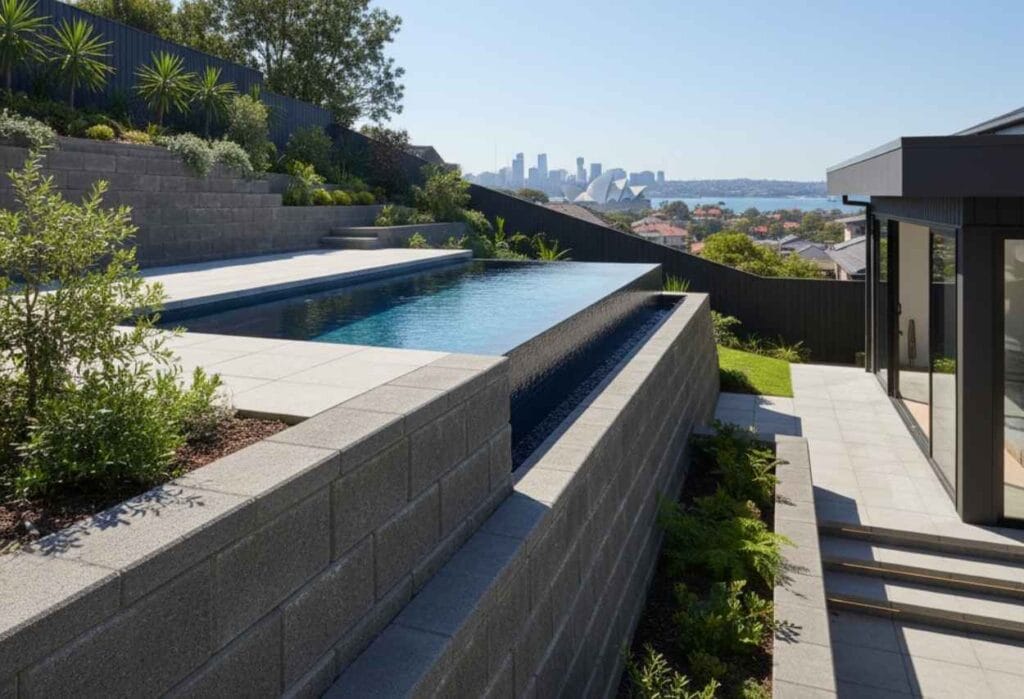
- Stone cladding: Offers a natural aesthetic to match leafy Brisbane surrounds.
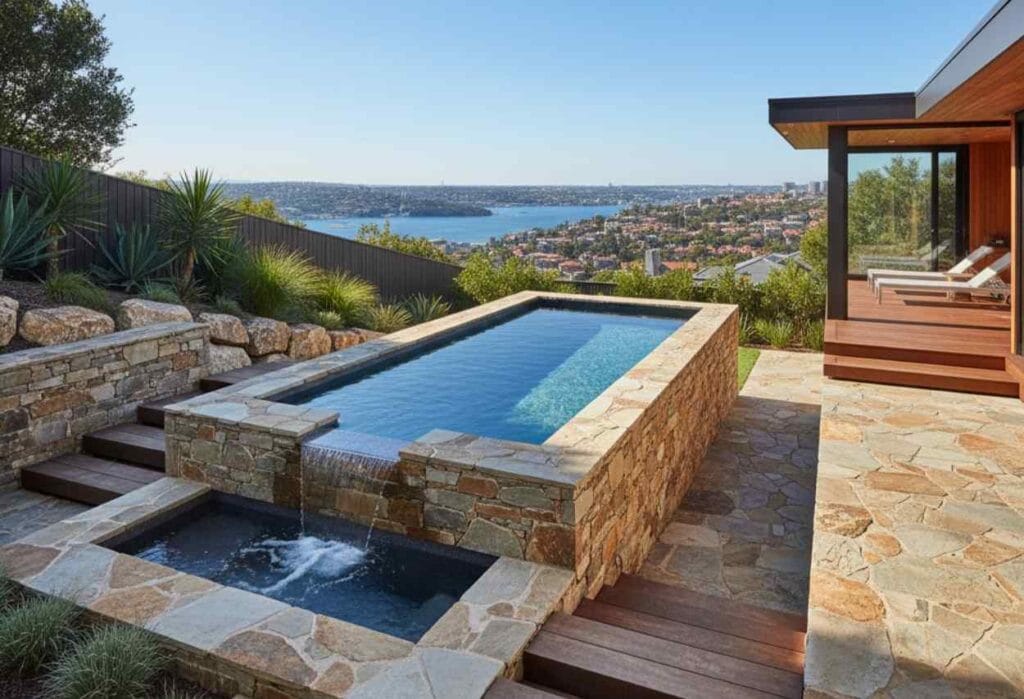
- Reinforced concrete: Provides maximum structural integrity for steep sites.
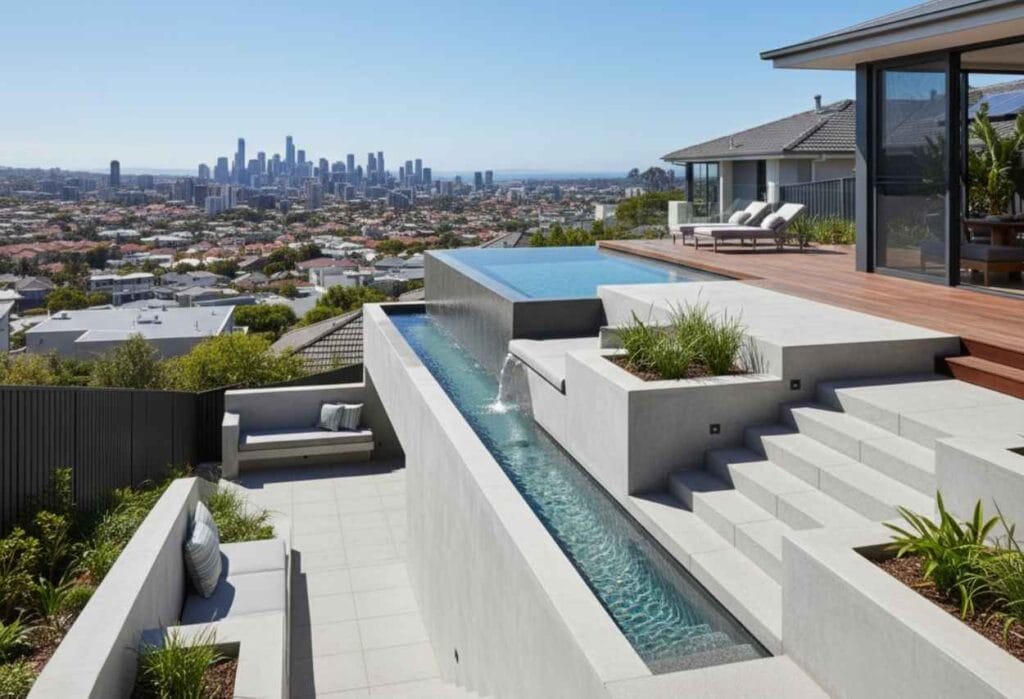
Structure + Aesthetic Value
Retaining walls don’t just hold soil. They can double as:
- Lighting features for night use
- Seating areas around the pool
- Planter boxes for greenery
Drainage Integration
Every retaining wall needs proper drainage to stay safe:
- Waterproofing membranes to stop leaks
- Weep holes to release water
- Gravel backfill to improve filtration
Permits & Safety Rules
- Pool fencing can be integrated into the wall if it meets safety codes.
- In Brisbane, any wall over 1 metre high requires council approval.
- Retaining walls near pools must align with Queensland pool fencing laws.
Drainage Solutions for Sloping Blocks
Drainage on sloped pool sites stops water pressure from building under the plunge pool shell. In Brisbane’s heavy rain, poor drainage can cause cracks, leaks, or wall failure. Common solutions include French drains, swales, weep holes, and subsurface pipes to keep water moving safely away.
Why Drainage is Critical
Sloped blocks collect water during storms. If it isn’t redirected, hydrostatic pressure pushes against the pool, walls, and soil. This can shift the structure or cause damage. Drainage systems protect both the pool and the surrounding landscaping.
Common Drainage Systems
- French drains: Gravel trenches with pipes that redirect groundwater.
- Swales: Shallow grass channels that guide surface water downhill.
- Weep holes: Small outlets built into retaining walls to let water escape.
- Subsurface pipes: Placed under or around the pool to release water pressure.
Stormwater Diversion
Brisbane City Council requires stormwater to be directed to legal points of discharge. This may include:
- Street drains
- Soakage pits
- Existing stormwater lines
Long-Term Maintenance
- Drainage needs regular checks to stay effective:
- Inspect retaining walls for leaks or bulges
- Clear debris from swales and pipes
- Test water outflow after heavy rain
Stepped Decks & Tiered Outdoor Living
Stepped decks and tiered outdoor areas make sloped pool sites safe and stylish. They create flat zones for dining, lounging, and gardens, while linking the house to the pool. Using durable materials like Modwood or spotted gum ensures decks last in Brisbane’s humid climate.
Benefits of Stepped Decks
- Smooth flow: Connects the house, pool, and yard on different levels.
- Multi-use zones: Separate spaces for dining, sunbathing, and play areas.
- Better views: Elevated decks highlight Brisbane’s leafy suburbs and city outlooks.
- Added value: A well-designed deck improves both lifestyle and property value.
Best Decking Materials for Brisbane
- Modwood (composite): Low maintenance and resistant to rot.
- Spotted gum (hardwood): Durable and attractive with natural colour.
- Anti-slip composite boards: Extra safety in wet conditions.
Safety & Comfort Features
- Shaded areas for hot summer days
- Non-slip coatings on all walkways
- Railings or balustrades for elevated sections
- LED or solar lighting for night use
Pool Safety and Compliance on Elevated Sites
Elevated pools in Queensland must meet strict safety laws. Fences must be at least 1.2 m high with self-closing gates, decks need non-slip surfaces, and fall prevention measures are required. A pool safety certificate is needed before the plunge pool can be legally filled.
Key Safety Rules in Queensland
- Fencing: At least 1.2 m high, with gates that close and latch automatically.
- Slip-resistant surfaces: Essential for decks, stairs, and walkways.
- Fall prevention: Balustrades or railings required on raised platforms.
- Safe access: Clear entry routes that meet disability and safety standards.
Certification & Compliance
- Before filling the pool, you must obtain a Form 23 Pool Safety Certificate.
- Brisbane City Council requires inspections to confirm fencing and access are compliant.
- Certificates are issued by licensed pool safety inspectors.
Why Compliance Matters
Meeting Queensland pool laws protects families and avoids fines. More importantly, it ensures your elevated plunge pool is safe to use all year round. At Plunge Pools Brisbane, we handle council approvals and safety checks to make the process stress-free.
Installation Logistics on Sloped Blocks
Installing a plunge pool on a sloped block in Brisbane usually needs cranes and careful staging. The process involves excavation, building retaining walls, setting up drainage, craning in the precast shell, and finishing with decking, landscaping, and compliance checks.
Typical Installation Steps
- Site excavation: Soil is cut, filled, or levelled to prepare the base.
- Retaining walls built: Support soil and create flat platforms.
- Drainage installed: Pipes, swales, or weep holes protect against Brisbane’s heavy rain.
- Precast shell craned in: A crane lifts the pool into position, sometimes with oversize load permits.
- Decking and landscaping finished: Adds access, safety, and visual appeal.
- Final inspections: Council and safety checks before filling the pool.
Crane & Access Considerations
- Narrow Brisbane streets may require smaller cranes or road closures.
- Oversized load permits may be needed for delivery.
- Site access planning reduces delays and extra costs.
Safety Management on Site
- Licensed builders follow strict Queensland construction safety laws.
- Temporary barriers protect workers and neighbours.
- Traffic control may be required during crane operations.
How Much Does a Precast Plunge Pool Cost on a Sloped Site in Brisbane?
A precast plunge pool on a sloped site in Brisbane usually costs from $40,000 to $60,000, depending on soil type, slope angle, and access. Extra expenses for soil tests, retaining walls, drainage, and crane hire can add another $5,000–$20,000 to the final price.
Average Cost Breakdown
| Item | Typical Cost in Brisbane | Notes |
|---|---|---|
| Soil testing & engineering | $1,000 – $3,000+ | Confirms ground stability |
| Retaining walls | $350 – $700 per m² | Needed for steep slopes |
| Drainage systems | $2,000 – $6,000+ | French drains, swales, pipes |
| Crane hire | $800 – $2,500+ | Larger cranes = higher cost |
| Council permits & inspections | $500 – $1,500+ | Required for walls & pool compliance |
Factors That Affect the Final Price
- Slope severity: Steeper sites mean more excavation, retaining walls, and structural support.
- Access for machinery: Narrow Brisbane streets (like Paddington) may need smaller cranes or road closures.
- Drainage needs: Extra pipes or swales for Brisbane’s heavy rain increase costs.
- Customisation: Decking, finishes, and landscaping can raise the total.
Why Extra Costs Are Worth It
While these additions increase upfront spend, they protect the pool from movement, water damage, and safety risks. In most cases, a precast plunge pool is still faster and more affordable than a fully custom concrete pool on a sloped block.
How Do You Integrate Landscape Design with a Sloped Pool Yard?
Landscape design on sloped pool sites uses terracing to create flat zones for dining, lounging, or gardens. Native plants help control erosion, vertical greenery adds privacy, and pathway lighting improves safety. Together, these features turn a slope into a usable and stylish outdoor space.
Key Landscape Features
- Terraced levels: Separate areas for dining, poolside lounging, gardens, or firepits.
- Erosion control plants: Native ground covers and shrubs reduce soil movement.
- Privacy screens: Vertical greenery or tiered planting adds seclusion.
- Lighting & flow: Ambient lights keep paths safe and create a relaxed mood.
- Functional zones: Firepit terraces, outdoor kitchens, or shaded pergolas add lifestyle value.
Benefits of Good Landscape Integration
- Turns steep yards into usable multi-level spaces.
- Improves safety and stability by reducing erosion.
- Adds privacy and comfort for families.
- Enhances property value with modern outdoor design.
In Brisbane’s climate, choose heat-tolerant native plants and install drainage-friendly soil layers. Avoid heavy water use during dry months, and plan shaded zones for summer heat.
Here are some example of the design zones for outdoor living:
- Poolside lounging
- Outdoor dining
- Firepit terraces
- Garden levels
When Is the Best Time to Build a Plunge Pool in Brisbane?
The best time to build a plunge pool in Brisbane is during the cooler, drier months from March to October. Avoid the wet season from November to February, as heavy rain and humidity make excavation harder and slow down curing of concrete and finishes.
Seasonal Considerations
- Dry months (Mar–Oct):
- Easier excavation and construction
- Faster curing and finishing
- Less chance of weather delays
- Wet season (Nov–Feb):
- Frequent storms cause soil instability
- High humidity slows curing
- Delays increase costs and risk of damage
Local Tip
If you’re planning for summer swimming, start construction in autumn or winter so the pool is finished and ready before the warmer months arrive.
Conclusion
A sloped block in Brisbane doesn’t have to be a challenge. With the right design, a precast plunge pool can turn it into a safe, stylish, and valuable feature for your home.
At Plunge Pools Brisbane, we specialise in designing plunge pools for sloping sites. Our team helps with approvals, drainage, and construction so you can enjoy a pool that looks great and lasts. Ready to explore your block? Contact us today for a site-specific consultation.
FAQS
Can you put a plunge pool on a slope?
Yes, you can install a plunge pool on a slope with the right planning. Engineers design retaining walls, drainage, and foundations to keep the pool safe and stable. Slopes can even improve your pool design by adding views and privacy.
How much does a plunge pool cost on a sloped site?
The cost of a plunge pool on a sloped site in Brisbane usually starts from $40,000 and increases with slope severity. Extra expenses include soil testing, retaining walls, drainage, and crane hire. Planning early helps manage costs effectively.
Do I need council approval for a plunge pool on a hill in Brisbane?
Yes, council approval is required for most sloped site pools. Brisbane City Council checks setback rules, slope stability, and safety compliance. At Plunge Pools Brisbane, we handle approvals to make the process stress-free.
How do you manage drainage around a sloped plunge pool?
Drainage is managed with systems like French drains, subsurface pipes, and swales. These prevent water build-up and pressure under the pool. Good drainage protects your pool shell and surrounding landscaping.
What are the safety requirements for pools on elevated blocks?
Pools on elevated blocks must meet Queensland fencing laws, with 1.2m high fences and self-closing gates. Non-slip surfaces, balustrades, and compliance certificates are also required before the pool can be used.
Can I still have decking around a plunge pool on a steep slope?
Yes, stepped or tiered decking works well with sloped sites. It creates safe, attractive zones for entertaining and relaxation. Decking materials like Modwood or spotted gum are ideal for Brisbane weather.

